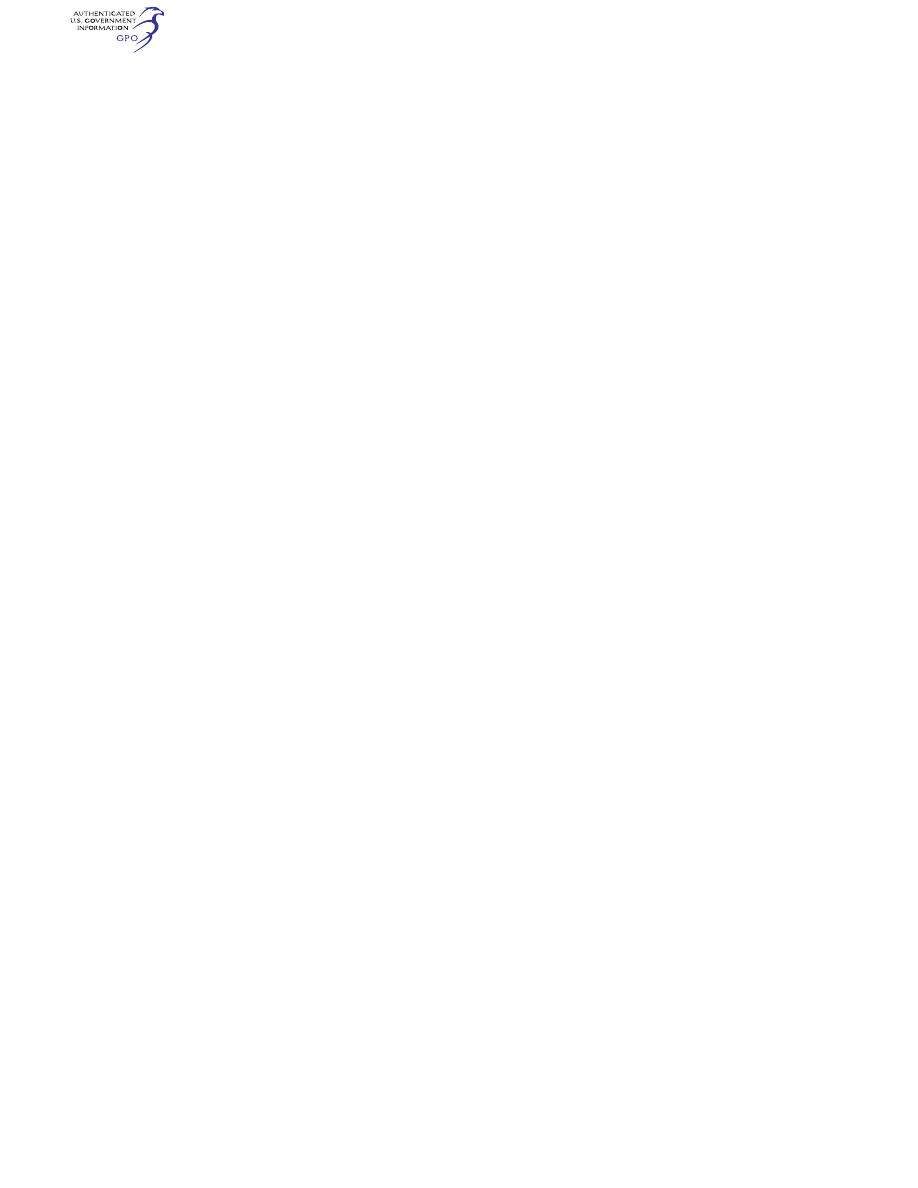
344
14 CFR Ch. I (1–1–24 Edition)
§ 125.211
(2) Enough approved life rafts (with
proper buoyancy) to carry all occu-
pants of the airplane, and at least the
following equipment for each raft
clearly marked for easy identifica-
tion—
(i) One canopy (for sail, sunshade, or
rain catcher);
(ii) One radar reflector (or similar de-
vice);
(iii) One life raft repair kit;
(iv) One bailing bucket;
(v) One signaling mirror;
(vi) One police whistle;
(vii) One raft knife;
(viii) One CO
2
bottle for emergency
inflation;
(ix) One inflation pump;
(x) Two oars;
(xi) One 75-foot retaining line;
(xii) One magnetic compass;
(xiii) One dye marker;
(xiv) One flashlight having at least
two size ‘‘D’’ cells or equivalent;
(xv) At least one approved pyro-
technic signaling device;
(xvi) A 2-day supply of emergency
food rations supplying at least 1,000
calories a day for each person;
(xvii) One sea water desalting kit for
each two persons that raft is rated to
carry, or two pints of water for each
person the raft is rated to carry;
(xviii) One fishing kit; and
(xix) One book on survival appro-
priate for the area in which the air-
plane is operated.
(b) No person may operate an air-
plane in extended overwater operations
unless there is attached to one of the
life rafts required by paragraph (a) of
this section, an approved survival type
emergency locator transmitter. Bat-
teries used in this transmitter must be
replaced (or recharged, if the batteries
are rechargeable) when the transmitter
has been in use for more than one cu-
mulative hour, or, when 50 percent of
their useful life (or for rechargeable
batteries, 50 percent of their useful life
of charge) has expired, as established
by the transmitter manufacturer under
its approval. The new expiration date
for replacing (or recharging) the bat-
tery must be legibly marked on the
outside of the transmitter. The battery
useful life (or useful life of charge) re-
quirements of this paragraph do not
apply to batteries (such as water-acti-
vated batteries) that are essentially
unaffected during probable storage in-
tervals.
[Doc. No. 19779, 45 FR 67235, Oct. 9, 1980, as
amended by Amdt. 125–20, 59 FR 32058, June
21, 1994]
§ 125.211 Seat and safety belts.
(a) No person may operate an air-
plane unless there are available during
the takeoff, en route flight, and land-
ing—
(1) An approved seat or berth for each
person on board the airplane who is at
least 2 years old; and
(2) An approved safety belt for sepa-
rate use by each person on board the
airplane who is at least 2 years old, ex-
cept that two persons occupying a
berth may share one approved safety
belt and two persons occupying a mul-
tiple lounge or divan seat may share
one approved safety belt during en
route flight only.
(b) Except as provided in paragraphs
(b)(1) and (b)(2) of this section, each
person on board an airplane operated
under this part shall occupy an ap-
proved seat or berth with a separate
safety belt properly secured about him
or her during movement on the surface,
takeoff, and landing. A safety belt pro-
vided for the occupant of a seat may
not be used for more than one person
who has reached his or her second
birthday. Notwithstanding the pre-
ceding requirements, a child may:
(1) Be held by an adult who is occu-
pying an approved seat or berth, pro-
vided the child has not reached his or
her second birthday and the child does
not occupy or use any restraining de-
vice; or
(2) Notwithstanding any other re-
quirement of this chapter, occupy an
approved child restraint system fur-
nished by the certificate holder or one
of the persons described in paragraph
(b)(2)(i) of this section, provided:
(i) The child is accompanied by a par-
ent, guardian, or attendant designated
by the child’s parent or guardian to at-
tend to the safety of the child during
the flight;
(ii) Except as provided in paragraph
(b)(2)(ii)(D) of this section, the ap-
proved child restraint system bears one
or more labels as follows:

345
Federal Aviation Administration, DOT
§ 125.211
(A) Seats manufactured to U.S.
standards between January 1, 1981, and
February 25, 1985, must bear the label:
‘‘This child restraint system conforms
to all applicable Federal motor vehicle
safety standards’’;
(B) Seats manufactured to U.S.
standards on or after February 26, 1985,
must bear two labels:
(
1
) ‘‘This child restraint system con-
forms to all applicable Federal motor
vehicle safety standards’’; and
(
2
) ‘‘THIS RESTRAINT IS CER-
TIFIED FOR USE IN MOTOR VEHI-
CLES AND AIRCRAFT’’ in red let-
tering;
(C) Seats that do not qualify under
paragraphs (b)(2)(ii)(A) and (b)(2)(ii)(B)
of this section must bear a label or
markings showing:
(
1
) That the seat was approved by a
foreign government;
(
2
) That the seat was manufactured
under the standards of the United Na-
tions;
(
3
) That the seat or child restraint
device furnished by the certificate
holder was approved by the FAA
through Type Certificate or Supple-
mental Type Certificate; or
(
4
) That the seat or child restraint
device furnished by the certificate
holder, or one of the persons described
in paragraph (b)(2)(i) of this section,
was approved by the FAA in accord-
ance with § 21.8(d) of this chapter or
Technical Standard Order C–100b, or a
later version. The child restraint de-
vice manufactured by AmSafe, Inc.
(CARES, Part No. 4082) and approved
by the FAA in accordance with
§ 21.305(d) (2010 ed.) of this chapter may
continue to bear a label or markings
showing FAA approval in accordance
with § 21.305(d) (2010 ed.) of this chapter.
(D) Except as provided in
§ 125.211(b)(2)(ii)(C)(
3
) and
§ 125.211(b)(2)(ii)(C)(
4
), booster-type
child restraint systems (as defined in
Federal Motor Vehicle Safety Standard
No. 213 (49 CFR 571.213)), vest- and har-
ness-type child restraint systems, and
lap held child restraints are not ap-
proved for use in aircraft; and
(iii) The certificate holder complies
with the following requirements:
(A) The restraint system must be
properly secured to an approved for-
ward-facing seat or berth;
(B) The child must be properly se-
cured in the restraint system and must
not exceed the specified weight limit
for the restraint system; and
(C) The restraint system must bear
the appropriate label(s).
(c) Except as provided in paragraph
(c)(3) of this section, the following pro-
hibitions apply to certificate holders:
(1) Except as provided in
§ 125.211(b)(2)(ii)(C)(
3
) and
§ 125.211(b)(2)(ii)(C)(
4
), no certificate
holder may permit a child, in an air-
craft, to occupy a booster-type child
restraint system, a vest-type child re-
straint system, a harness-type child re-
straint system, or a lap held child re-
straint system during take off, landing,
and movement on the surface.
(2) Except as required in paragraph
(c)(1) of this section, no certificate
holder may prohibit a child, if re-
quested by the child’s parent, guardian,
or designated attendant, from occu-
pying a child restraint system fur-
nished by the child’s parent, guardian,
or designated attendant provided:
(i) The child holds a ticket for an ap-
proved seat or berth or such seat or
berth is otherwise made available by
the certificate holder for the child’s
use;
(ii) The requirements of paragraph
(b)(2)(i) of this section are met;
(iii) The requirements of paragraph
(b)(2)(iii) of this section are met; and
(iv) The child restraint system has
one or more of the labels described in
paragraphs (b)(2)(ii)(A) through
(b)(2)(ii)(C) of this section.
(3) This section does not prohibit the
certificate holder from providing child
restraint systems authorized by this
section or, consistent with safe oper-
ating practices, determining the most
appropriate passenger seat location for
the child restraint system.
(d) Each sideward facing seat must
comply with the applicable require-
ments of § 25.785(c) of this chapter.
(e) No certificate holder may take off
or land an airplane unless each pas-
senger seat back is in the upright posi-
tion. Each passenger shall comply with
instructions given by a crewmember in
compliance with this paragraph. This
paragraph does not apply to seats on
which cargo or persons who are unable
to sit erect for a medical reason are

346
14 CFR Ch. I (1–1–24 Edition)
§ 125.213
carried in accordance with procedures
in the certificate holder’s manual if
the seat back does not obstruct any
passenger’s access to the aisle or to
any emergency exit.
(f) Each occupant of a seat equipped
with a shoulder harness must fasten
the shoulder harness during takeoff
and landing, except that, in the case of
crewmembers, the shoulder harness
need not be fastened if the crew-
member cannot perform his required
duties with the shoulder harness fas-
tened.
[Doc. No. 19799, 45 FR 67235, Oct. 9, 1980, as
amended by Amdt. 125–17, 57 FR 42674, Sept.
15, 1992; Amdt. 125–26, 61 FR 28422, June 4,
1996; Amdt. 125–48, 70 FR 50907, Aug. 26, 2005;
Amdt. 125–51, 71 FR 40009, July 14, 2006; 71 FR
59373, Oct. 10, 2006; Amdt. 125–64, 79 FR 28812,
May 20, 2014]
§ 125.213 Miscellaneous equipment.
No person may conduct any oper-
ation unless the following equipment is
installed in the airplane:
(a) If protective fuses are installed on
an airplane, the number of spare fuses
approved for the airplane and appro-
priately described in the certificate
holder’s manual.
(b) A windshield wiper or equivalent
for each pilot station.
(c) A power supply and distribution
system that meets the requirements of
§§ 25.1309, 25.1331, 25.1351 (a) and (b) (1)
through (4), 25.1353, 25.1355, and
25.1431(b) or that is able to produce and
distribute the load for the required in-
struments and equipment, with use of
an external power supply if any one
power source or component of the
power distribution system fails. The
use of common elements in the system
may be approved if the Administrator
finds that they are designed to be rea-
sonably protected against malfunc-
tioning. Engine-driven sources of en-
ergy, when used, must be on separate
engines.
(d) A means for indicating the ade-
quacy of the power being supplied to
required flight instruments.
(e) Two independent static pressure
systems, vented to the outside atmos-
pheric pressure so that they will be
least affected by air flow variation or
moisture or other foreign matter, and
installed so as to be airtight except for
the vent. When a means is provided for
transferring an instrument from its
primary operating system to an alter-
native system, the means must include
a positive positioning control and must
be marked to indicate clearly which
system is being used.
(f) A placard on each door that is the
means of access to a required passenger
emergency exit to indicate that it
must be open during takeoff and land-
ing.
(g) A means for the crew, in an emer-
gency, to unlock each door that leads
to a compartment that is normally ac-
cessible to passengers and that can be
locked by passengers.
§ 125.215 Operating information re-
quired.
(a) The operator of an airplane must
provide the following materials, in cur-
rent and appropriate form, accessible
to the pilot at the pilot station, and
the pilot shall use them:
(1) A cockpit checklist.
(2) An emergency cockpit checklist
containing the procedures required by
paragraph (c) of this section, as appro-
priate.
(3) Pertinent aeronautical charts.
(4) For IFR operations, each perti-
nent navigational en route, terminal
area, and approach and letdown chart;
(5) One-engine-inoperative climb per-
formance data and, if the airplane is
approved for use in IFR or over-the-top
operations, that data must be suffi-
cient to enable the pilot to determine
that the airplane is capable of carrying
passengers over-the-top or in IFR con-
ditions at a weight that will allow it to
climb, with the critical engine inoper-
ative, at least 50 feet a minute when
operating at the MEA’s of the route to
be flown or 5,000 feet MSL, whichever is
higher.
(b) Each cockpit checklist required
by paragraph (a)(1) of this section must
contain the following procedures:
(1) Before starting engines;
(2) Before take-off;
(3) Cruise;
(4) Before landing;
(5) After landing;
(6) Stopping engines.


